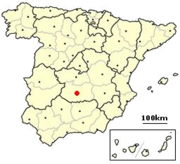Battle of Alarcos
This article includes a list of general references, but it lacks sufficient corresponding inline citations. (July 2020) |
| Battle of Alarcos | |||||||
|---|---|---|---|---|---|---|---|
| Part of the Reconquista | |||||||
 Alarcos castle | |||||||
| |||||||
| Belligerents | |||||||
|
Order of St. Benedict |
Almohad Caliphate Castilian rebels | ||||||
| Commanders and leaders | |||||||
|
|
Abu Yusuf Ya'qub al-Mansur Pedro Fernández de Castro | ||||||
| Strength | |||||||
|
Undetermined Modern estimate: More than 25,000 [2] |
Undetermined Modern estimate: 20,000-30,000 [2] | ||||||

Battle of Alarcos (July 18, 1195),
Background
In 1189 the
An armistice between the Almohads and the Christian kings of
On the first day of June, 1195, he landed at
Alfonso gathered his forces at Toledo and marched down to Alarcos (al-Arak, in Arabic), near the Guadiana River, a place which marked the Southern limit of his kingdom and where a fortress was under construction. He intended on barring the access to the rich Tagus valley, and did not wait for the reinforcements the Kings Alfonso IX of León and Sancho VII of Navarre were sending.[4] When on July 16 the Almohad host came in view, Yaqub al-Mansur did not accept battle on this day or the day after, preferring to give rest to his forces; but early the day after that, Wednesday, July 18, the Almohad army formed for battle around a small hill called La Cabeza, two bow-shots from Alarcos.
Battle
Yusuf Ya'qub al-Mansur gave to his vizier, Abu Yahya ibn Abi Hafs, command of a very strong vanguard: on the first line the
The
Alfonso advanced with all his remaining forces into the melee, only to find himself assaulted from all sides and under a rain of arrows. For some time he fought hand-to-hand, until removed from the action, almost by force, by his bodyguard; they fled towards Toledo. The Castilian infantry was destroyed, together with most of the Orders which had supported them; the Lord of Vizcaya tried to force his way through the ring of enemy forces, but finally had to seek refuge in the unfinished fortress of Alarcos with just a fraction of his knights. The castle was surrounded with some 3,000 people trapped inside, half of them women and children. The king's enemy, Pedro Fernández de Castro, who had taken little part in the action, was sent by the
The Castilian field army had been destroyed. Those killed included three bishops (from Avila, Segovia, and Siguenza);
Aftermath
The outcome of the battle shook the stability of the
For the next two years, al-Mansur's forces devastated Extremadura, the
But the caliph was losing interest in the affairs of the Iberian Peninsula; he was in poor health, his objective of retaining a hold over al-Andalus appeared to be a complete success, and in 1198 he returned to Africa. He died in February 1199.
However, the success of the battle proved to be short-lived. When the Almohad caliph
Notes
References
Citations
- ^ Battle of Alarcos, Theresa M. Vann, Medieval Iberia: An Encyclopedia, Ed. E. Michael Gerli and Samuel G. Armistead, (Taylor & Francis, 2003), 42.
- ^ a b Kaufmann, Kaufmann & Jurga 2004, p. 101
- ^ a b Britannica.com
- ^ a b c Medieval Iberia: an encyclopedia, 42.
- ^ Abdelwahid al-Marrakushi"Al-Mojib fi Talkhis Akhbar al-Maghrib" [The Pleasant In Summarizing the History of the Maghreb"] (1224), pp. 136–137
- ^ Aḥmad ibn Muḥammad Maqqarī, Ibn al-Khaṭīb, The history of the Mohammedan dynasties in Spain, (Johnson Reprint Corporation, 1843), lxv.
- ^ King, Georgiana Goddard, A brief account of the military orders in Spain, (The Hispanic Society of America, 1921), 26.
Bibliography
- Kaufmann, J. E.; Kaufmann, H. W.; Jurga, Robert M. (2004). The Medieval Fortress: Castles, Forts, And Walled Cities Of The Middle Ages. Cambridge: Da Capo Press. ISBN 978-0-306-81358-0.
- Aḥmad ibn Muḥammad Maqqarī, Ibn al-Khaṭīb, The history of the Mohammedan dynasties in Spain, Vol.2, Johnson Reprint Corporation, 1843.
- Britannica.com
- King, Georgiana Goddard, A brief account of the military orders in Spain, The Hispanic Society of America, 1921.
- Medieval Iberia: an encyclopedia, Ed. E. Michael Gerli and Samuel G. Armistead, Taylor & Francis, 2003.
